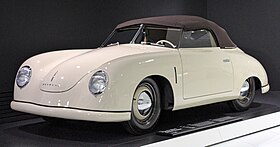| Porsche 356/2 | |
|---|---|
 Porsche 356/2 | |
| Overview | |
| Manufacturer | Porsche |
| Also called | Porsche Gmund |
| Production |
|
| Assembly |
|
| Designer | Ferry Porsche, Erwin Komenda |
| Body and chassis | |
| Class | Sports car |
| Body style | 2-door Coupe and Cabriolet |
| Layout | Rear-engine, rear-wheel drive layout |
| Doors | 2 |
| Related | Porsche 356/1, 356 Pre-A, |
| Powertrain | |
| Engine |
|
| Dimensions | |
| Wheelbase | 2,100 mm (82.7 in) |
| Length | 3,880 mm (152.8 in) |
| Width | 1,666 mm (65.6 in) |
| Height | 1,300 mm (51.2 in) |
| Chronology | |
| Predecessor | Porsche 356/1 |
| Successor | Porsche 356 |



The Porsche 356/2, produced in Gmünd, Austria, was the first iteration of the Porsche 356 sports car. Produced between 1948 and 1951, the Porsche 356/2 was the first series production aluminum bodied sports car of Porsche after the creation of the 356-001 one-off prototype in Gmund Austria.[1] It was built in limited numbers, making it a highly sought-after collector's item today.[1][2]
The Porsche 356/2 was designed by Ferry Porsche and Erwin Komenda, and was based on components from the Volkswagen Beetle. The car was built using lightweight aluminum body panels and a welded steel box chassis with integrated floorplan, which helped to keep its weight low and provide nimble handling. The flat-four engine, which was also based on the Volkswagen Beetle, provided lively performance and was mounted in the rear of the car.
The exterior design of the Porsche 356/2 featured a sloping hood, rounded fenders, and a streamlined profile. The car was available in both a coupé and cabriolet body style, and the interior was designed to be functional, with a simple dashboard and instrument panel. The car was also equipped with large windows, providing excellent visibility.
One of the defining features of the Porsche 356/2 produced in Gmünd was its hand-built construction. Each car was built by a small team of craftsmen, and each car was given its own unique character and attention to detail.[1]
The Porsche 356/2 was a popular choice for racing and rally events, and many early Porsche racing drivers cut their teeth in this car. The car's nimble handling and quick acceleration made it well suited to the demands of competition driving, and the car's success on the track helped to establish Porsche's reputation as a manufacturer of high-performance sports cars.[3][4]
About 32 aluminum bodied Porsche 356 cars are still in existence, including the 356-001 roadster prototype in the Porsche museum.
- ^ a b c Cite error: The named reference
:2was invoked but never defined (see the help page). - ^ Leffingwell, Randy (1 January 2014). Porsche Unexpected: Discoveries in Collecting. Coachbuilt Press. ISBN 978-0-9882-7333-7.
- ^ Cite error: The named reference
:5was invoked but never defined (see the help page). - ^ Cite error: The named reference
:4was invoked but never defined (see the help page).
